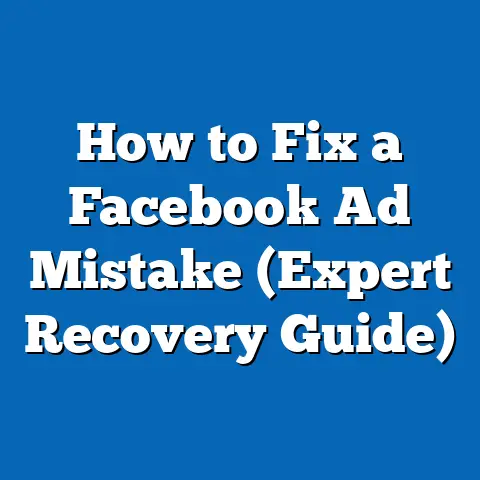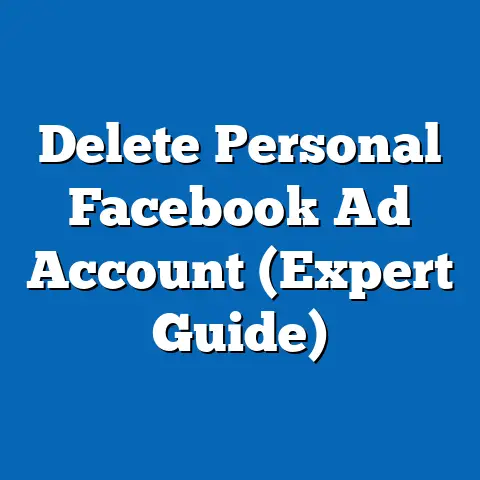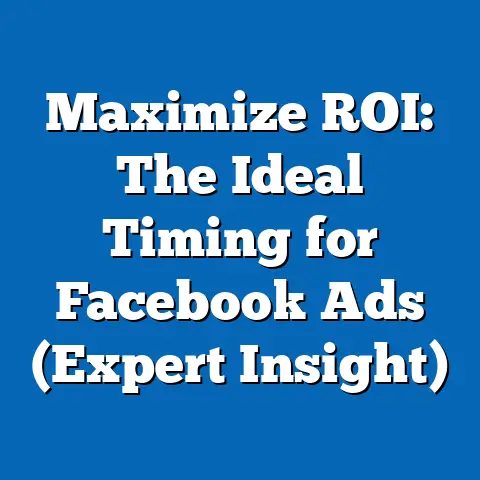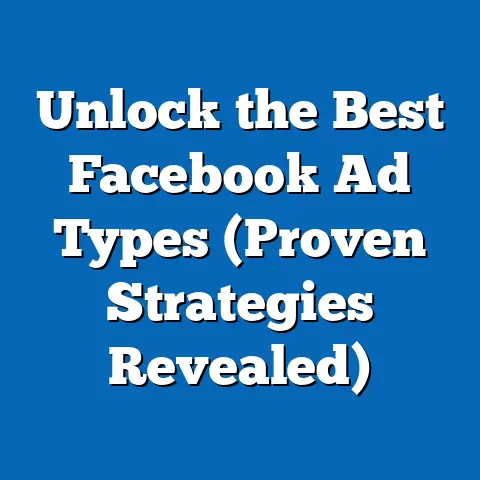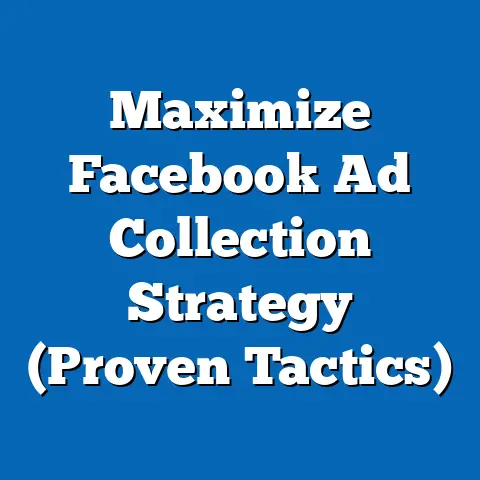Master Facebook Ads Strategy 2025 (Future-Proof Techniques)
Facebook. It’s a name that’s become synonymous with social media, connecting billions across the globe. But beyond personal connections, Facebook has cemented itself as a powerhouse in the advertising world. As a digital marketer with over a decade of experience, I’ve witnessed firsthand the platform’s evolution from simple banner ads to sophisticated, data-driven campaigns. And believe me, it’s been a wild ride!
In 2025, Facebook, now under the Meta umbrella, isn’t just another platform; it’s a cornerstone of digital marketing. Ignoring it is like ignoring a giant storefront on the busiest street in the world. The key, however, lies in adapting and mastering strategies that not only work today but will continue to deliver results in the face of ever-changing algorithms, user behaviors, and technological advancements.
Consider this your roadmap to becoming a Facebook Ads master in 2025 and beyond. Buckle up, because we’re about to dive in!
1. Understanding the Evolution of Facebook Ads
To truly understand where Facebook Ads are going, we need to take a look at where they’ve been. I remember when Facebook Ads first launched; they were clunky, basic, and often felt like an afterthought. Think simple text ads with limited targeting options – a far cry from the sophisticated platform we know today.
A Historical Overview: From Simple Ads to AI-Powered Campaigns
The journey of Facebook Ads can be broken down into several key phases:
- The Early Days (2004-2007): Initially, Facebook Ads were primarily focused on driving traffic to external websites. Targeting was limited to basic demographics like age, location, and interests. The emphasis was on reach rather than precision.
- The Social Advertising Revolution (2007-2012): This era saw the introduction of social ads, which leveraged the power of social connections. Ads could now incorporate user endorsements, likes, and shares, making them more engaging and trustworthy. The introduction of the Facebook Pixel also marked a turning point, allowing businesses to track conversions and optimize their campaigns more effectively.
- The Mobile-First Era (2012-2017): With the rise of smartphones, Facebook shifted its focus to mobile advertising. Ad formats were optimized for smaller screens, and new targeting options based on mobile usage and behavior were introduced. This period also saw the emergence of video ads as a dominant format.
- The Data-Driven Age (2017-Present): This is the era we’re currently in, characterized by the increasing use of data and analytics to drive ad performance. Facebook has invested heavily in AI and machine learning, enabling advertisers to target audiences with unprecedented precision and personalize ad experiences at scale.
Factors Influencing Change: Privacy, Algorithms, and User Behavior
Several key factors have shaped the evolution of Facebook advertising:
- User Privacy Concerns: The Cambridge Analytica scandal and other privacy breaches have led to increased scrutiny of Facebook’s data collection practices. This has resulted in stricter regulations, such as GDPR and CCPA, which have forced Facebook to limit the amount of data it collects and give users more control over their privacy settings.
- Algorithm Updates: Facebook’s algorithm is constantly evolving to prioritize user experience. This means that organic reach for businesses has declined significantly, making paid advertising even more essential. However, algorithm updates can also impact the performance of ad campaigns, requiring advertisers to stay agile and adapt their strategies accordingly. I’ve personally had to revamp entire campaigns overnight after an unexpected algorithm shift!
- Shifts in Consumer Behavior: Consumer behavior is constantly evolving, driven by technological advancements and changing social norms. Facebook advertisers need to stay on top of these trends and adapt their messaging and targeting to resonate with today’s consumers. For instance, the rise of short-form video content on platforms like TikTok has influenced Facebook’s own video ad formats.
Shaping the Future: Preparing for What’s Next
These factors will continue to shape the future of Facebook advertising. We can expect to see:
- Increased Emphasis on Privacy-Preserving Advertising: Facebook will likely invest in technologies that allow advertisers to target audiences without relying on personal data. This could include techniques like aggregated anonymized data and contextual advertising.
- Greater Reliance on AI and Machine Learning: AI will play an even more significant role in ad targeting, optimization, and creative development. Advertisers will need to embrace AI-powered tools to stay competitive.
- More Immersive Ad Experiences: As technologies like AR and VR become more mainstream, Facebook will likely introduce new ad formats that leverage these technologies to create more engaging and immersive experiences.
Takeaway: Understanding the history and the driving forces behind the evolution of Facebook Ads is crucial for anticipating future changes and adapting your strategies accordingly. Don’t get stuck in the past; embrace the future!
2. Key Trends Shaping Facebook Advertising in 2025
Now that we’ve explored the past, let’s turn our attention to the future. What are the key trends that will shape Facebook advertising in 2025? As someone who spends hours analyzing market data and experimenting with new ad formats, I’ve identified four major trends that marketers need to be aware of.
1. The AI Revolution: Smarter Targeting and Optimization
Artificial intelligence (AI) and machine learning (ML) are already transforming the advertising landscape, and their impact will only intensify in 2025. Facebook is investing heavily in AI to improve its ad platform, offering advertisers more sophisticated targeting and optimization capabilities.
- AI-Powered Targeting: AI algorithms can analyze vast amounts of data to identify patterns and predict which users are most likely to convert. This allows advertisers to target audiences with unprecedented precision, even without relying on personal data. For example, AI can identify users who share similar characteristics to your existing customers, even if they haven’t explicitly expressed interest in your product or service.
- Automated Optimization: AI can also automate many of the tasks that used to require manual intervention, such as bid management, ad placement, and creative testing. This frees up advertisers to focus on strategy and creative development, while AI handles the day-to-day optimization of their campaigns. I’ve seen campaigns go from mediocre to outstanding simply by letting Facebook’s AI take the reins.
Example: Imagine you’re selling a new line of eco-friendly clothing. Instead of manually targeting users based on interests like “sustainable living” or “organic fashion,” you can let Facebook’s AI identify users who have shown a propensity to purchase similar products in the past, even if they haven’t explicitly expressed interest in environmental issues.
2. Immersive Experiences: AR and VR Ads
Augmented reality (AR) and virtual reality (VR) are no longer futuristic fantasies; they’re becoming increasingly mainstream technologies. Facebook is already experimenting with AR ads, allowing users to try on products virtually or interact with brands in new and engaging ways.
- AR Ads: AR ads allow users to overlay digital images and animations onto the real world using their smartphone cameras. This creates a more immersive and interactive ad experience that can drive engagement and conversions.
- VR Ads: VR ads take immersion to the next level, transporting users to virtual environments where they can interact with brands and products in a fully immersive way. While VR adoption is still relatively low, it has the potential to revolutionize advertising in the long run.
Example: A furniture retailer could create an AR ad that allows users to virtually place a sofa in their living room to see how it looks before making a purchase. Or, a travel company could create a VR ad that transports users to a virtual beach resort, allowing them to experience the destination before booking their vacation.
3. The Rise of Video: Short-Form and Live Streaming
Video content continues to dominate the internet, and Facebook is no exception. In 2025, we can expect to see an even greater emphasis on video ads, particularly short-form videos and live streaming.
- Short-Form Video Ads: Inspired by the success of TikTok, Facebook has introduced Reels, a short-form video format that’s ideal for capturing attention and driving engagement. Short-form video ads are perfect for conveying concise messages and showcasing products in a visually appealing way.
- Live Streaming Ads: Live streaming is another powerful way to connect with audiences in real-time. Facebook Live allows businesses to host live events, Q&A sessions, and product demonstrations, creating a sense of community and driving engagement.
Example: A cosmetics brand could create a short-form video ad showcasing a quick makeup tutorial using their products. Or, a fitness instructor could host a live workout session on Facebook Live, promoting their online fitness program.
4. Hyper-Personalization: Data-Driven Customer Insights
Data analytics and customer insights are becoming increasingly sophisticated, allowing advertisers to personalize ad experiences at scale. In 2025, we can expect to see even more advanced personalization techniques, driven by AI and machine learning.
- Dynamic Product Ads: Dynamic product ads allow you to automatically show users ads for products they’ve previously viewed on your website or app. This is a highly effective way to retarget users and drive conversions.
- Personalized Messaging: By analyzing data about user demographics, interests, and behavior, you can create personalized ad messages that resonate with individual users. This can significantly improve engagement and conversion rates.
Example: An e-commerce store could show a user an ad for a specific pair of shoes they viewed on their website but didn’t purchase. Or, a subscription service could show a user a personalized ad highlighting the benefits of their premium plan based on their past usage of the free plan.
Takeaway: By embracing these key trends, you can position your Facebook advertising campaigns for success in 2025 and beyond. Don’t be afraid to experiment with new technologies and formats, and always prioritize data-driven decision-making.
3. Crafting Future-Proof Ads
The future of Facebook advertising isn’t just about fancy tech; it’s about crafting ads that resonate with people on a human level. As I always tell my clients, technology is the vehicle, but the message is the fuel. Here’s how to create ads that will stand the test of time.
Storytelling: Connecting with Audiences on an Emotional Level
In a world saturated with advertising, storytelling is essential for capturing attention and building connections with audiences. People are more likely to remember and engage with ads that tell a compelling story that resonates with their emotions.
- Focus on the Customer’s Journey: Instead of focusing on your product’s features, tell a story about how your product helps customers solve a problem or achieve a goal.
- Use Authentic Voices: Feature real customers in your ads and let them tell their stories in their own words. This can make your ads more relatable and trustworthy.
- Create a Narrative Arc: Every good story has a beginning, middle, and end. Use this structure to create ads that take viewers on a journey and leave them with a lasting impression.
Example: A non-profit organization could create an ad that tells the story of a person whose life was transformed by their services. The ad could start by showing the person struggling with a problem, then show how the organization helped them overcome that problem, and finally show the person thriving and living a fulfilling life.
Authenticity and Transparency: Building Trust with Consumers
In an era of fake news and misinformation, authenticity and transparency are more important than ever. Consumers are increasingly skeptical of advertising, and they’re more likely to trust brands that are honest and transparent.
- Be Upfront About Your Product’s Limitations: Don’t try to hide your product’s flaws or exaggerate its benefits. Be honest about what your product can and can’t do.
- Show Behind-the-Scenes Footage: Give viewers a glimpse into your company’s culture and values. This can help build trust and make your brand more relatable.
- Respond to Criticism: Don’t ignore negative reviews or comments. Respond to them promptly and professionally, and try to address the concerns raised.
Example: A food company could create an ad that shows how their products are made, highlighting the quality of their ingredients and their commitment to ethical sourcing. They could also address common criticisms of their products, such as concerns about sugar content or preservatives.
Creative Design: Engaging and Converting Viewers
Even the best story won’t resonate if it’s not presented in a visually appealing way. Creative design is essential for capturing attention and driving engagement.
- Use High-Quality Visuals: Invest in professional photography and videography to create ads that look polished and professional.
- Keep it Simple: Don’t overcrowd your ads with too much text or too many visuals. Focus on conveying a clear and concise message.
- Use Eye-Catching Animations: Animations can be a great way to capture attention and add visual interest to your ads.
Example: A fashion brand could create an ad that showcases their latest collection using stunning visuals and dynamic animations. They could also use a simple and clean design to focus attention on the clothing.
Case Studies: Learning from Success
Let’s take a look at some real-world examples of successful campaigns that exemplify these principles:
- Dove’s “Real Beauty” Campaign: This campaign challenged traditional beauty standards by featuring real women of all shapes and sizes. The campaign resonated with audiences because it was authentic, relatable, and empowering.
- Airbnb’s “Belong Anywhere” Campaign: This campaign told stories of people from all over the world who used Airbnb to connect with local communities and experience new cultures. The campaign resonated with audiences because it was inspiring, adventurous, and humanistic.
- Nike’s “Just Do It” Campaign: This campaign has been running for over 30 years, and it continues to resonate with audiences because it’s motivational, empowering, and timeless. The campaign encourages people to overcome challenges and achieve their goals, regardless of their background or abilities.
Takeaway: Crafting future-proof ads is about more than just following the latest trends. It’s about understanding what resonates with people on a human level and creating ads that are authentic, engaging, and visually appealing.
4. Advanced Targeting Strategies
Even the most compelling ad will fall flat if it’s not shown to the right audience. As Facebook’s ad platform has evolved, so have its targeting capabilities. In 2025, advanced targeting strategies will be essential for maximizing ROI.
Custom Audiences: Reaching Your Existing Customers
Custom Audiences allow you to target users who have already interacted with your business, either online or offline. This is a highly effective way to re-engage existing customers and drive conversions.
- Website Custom Audiences: Target users who have visited your website or specific pages on your website. This is a great way to retarget users who have shown interest in your products or services.
- Customer List Custom Audiences: Upload a list of your customer email addresses or phone numbers to target those users on Facebook. This is a great way to promote special offers or new products to your existing customer base.
- App Activity Custom Audiences: Target users who have interacted with your mobile app. This is a great way to re-engage app users and drive in-app purchases.
Example: An e-commerce store could create a Website Custom Audience to target users who have added items to their cart but haven’t completed their purchase. They could then show those users an ad with a special discount to encourage them to complete their purchase.
Lookalike Audiences: Finding New Customers
Lookalike Audiences allow you to target users who share similar characteristics to your existing customers. This is a great way to expand your reach and find new customers who are likely to be interested in your products or services.
- Source Audience: You can create a Lookalike Audience based on any of your Custom Audiences, such as your website visitors, customer list, or app users.
- Similarity Percentage: You can choose how similar you want your Lookalike Audience to be to your source audience. A smaller percentage will result in a more targeted audience, while a larger percentage will result in a broader audience.
Example: An e-commerce store could create a Lookalike Audience based on their customer list. Facebook will then identify users who share similar demographics, interests, and behaviors to their existing customers and show them ads for the store’s products.
Behavioral and Interest-Based Targeting: Reaching Niche Audiences
Behavioral and interest-based targeting allows you to target users based on their online behavior and interests. This is a great way to reach niche audiences who are passionate about specific topics or activities.
- Interests: Target users based on their declared interests on Facebook, such as “sports,” “fashion,” or “travel.”
- Behaviors: Target users based on their online behavior, such as “purchased a product online,” “traveled internationally,” or “watches a lot of videos.”
- Demographics: Target users based on their demographics, such as age, gender, location, and education level.
Example: A sports apparel company could target users who have expressed interest in specific sports, such as “basketball,” “soccer,” or “running.” They could also target users who have purchased sports apparel online in the past.
The Role of Pixel Tracking and Retargeting
The Facebook Pixel is a snippet of code that you can install on your website to track user behavior. This data can then be used to create Custom Audiences and optimize your ad campaigns.
- Track Conversions: The Pixel allows you to track conversions, such as purchases, leads, and sign-ups. This data can be used to measure the effectiveness of your ad campaigns and optimize your targeting.
- Retarget Website Visitors: The Pixel allows you to retarget users who have visited your website but haven’t converted. This is a highly effective way to re-engage potential customers and drive conversions.
Example: An e-commerce store could use the Pixel to track which products users are viewing on their website. They could then retarget those users with ads for those specific products, encouraging them to complete their purchase.
Takeaway: Advanced targeting strategies are essential for maximizing ROI on Facebook advertising. By leveraging Custom Audiences, Lookalike Audiences, behavioral and interest-based targeting, and Pixel tracking, you can reach the right audience with the right message at the right time.
5. Measuring Success and Optimization
In the data-driven world of Facebook advertising, measuring success is just as important as crafting compelling ads and targeting the right audience. As the saying goes, “What gets measured gets managed.”
Key Performance Indicators (KPIs): Focusing on What Matters
Key Performance Indicators (KPIs) are metrics that you can use to track the performance of your ad campaigns. It’s important to focus on the KPIs that are most relevant to your business goals.
- Reach: The number of unique users who saw your ad.
- Impressions: The number of times your ad was displayed.
- Click-Through Rate (CTR): The percentage of users who clicked on your ad after seeing it.
- Cost Per Click (CPC): The average cost you paid for each click on your ad.
- Conversion Rate: The percentage of users who completed a desired action, such as making a purchase or filling out a form, after clicking on your ad.
- Cost Per Acquisition (CPA): The average cost you paid for each conversion.
- Return on Ad Spend (ROAS): The amount of revenue you generated for every dollar you spent on advertising.
Example: If your goal is to drive sales, you should focus on KPIs like Conversion Rate, CPA, and ROAS. If your goal is to increase brand awareness, you should focus on KPIs like Reach, Impressions, and CTR.
Tools and Analytics Platforms: Interpreting the Data
Facebook provides a variety of tools and analytics platforms that can help you track and interpret your data.
- Facebook Ads Manager: The Ads Manager is the primary tool for creating and managing your ad campaigns. It provides detailed data on your ad performance, including Reach, Impressions, CTR, CPC, Conversion Rate, CPA, and ROAS.
- Facebook Analytics: Facebook Analytics allows you to track user behavior on your website or app. This data can be used to create Custom Audiences, optimize your ad campaigns, and understand your customers better.
- Google Analytics: Google Analytics is a free web analytics service that allows you to track user behavior on your website. This data can be used to understand how users are interacting with your website after clicking on your Facebook ads.
Example: You can use Facebook Ads Manager to track the performance of your ad campaigns and identify which ads are generating the most conversions. You can then use Facebook Analytics to track how users are interacting with your website after clicking on your ads, such as which pages they are visiting and how long they are spending on each page.
A/B Testing: Continuous Optimization
A/B testing is a method of comparing two versions of an ad to see which one performs better. This is a great way to continuously optimize your ad campaigns and improve your results.
- Test Different Headlines: Try testing different headlines to see which one captures the most attention.
- Test Different Images: Try testing different images to see which one is the most visually appealing.
- Test Different Call-to-Actions: Try testing different call-to-actions to see which one encourages the most users to take action.
- Test Different Targeting Options: Try testing different targeting options to see which audience is the most responsive.
Example: You could create two versions of an ad, one with a headline that emphasizes the benefits of your product and another with a headline that emphasizes the price of your product. You could then run both ads simultaneously and see which one generates more clicks and conversions.
Takeaway: Measuring success and optimization are essential for maximizing ROI on Facebook advertising. By focusing on the right KPIs, using the right tools, and continuously A/B testing your ads, you can ensure that your campaigns are performing at their best.
6. Preparing for Regulatory Changes
The regulatory landscape for digital advertising is constantly evolving, and it’s important to stay informed about the latest changes. In 2025, privacy laws and data protection regulations will continue to have a significant impact on Facebook advertising.
Privacy Laws and Data Protection Regulations: Understanding the Rules
Privacy laws and data protection regulations, such as GDPR and CCPA, are designed to protect consumers’ personal data. These regulations place restrictions on how businesses can collect, use, and share personal data for advertising purposes.
- GDPR (General Data Protection Regulation): GDPR is a European Union regulation that applies to businesses that collect or process personal data of EU residents. It requires businesses to obtain explicit consent from users before collecting their data and to provide users with the right to access, correct, and delete their data.
- CCPA (California Consumer Privacy Act): CCPA is a California law that gives California residents the right to know what personal data businesses collect about them, the right to delete their personal data, and the right to opt-out of the sale of their personal data.
Example: If you’re running Facebook ads in the EU or California, you need to comply with GDPR and CCPA. This means that you need to obtain explicit consent from users before collecting their data, and you need to provide users with the right to access, correct, and delete their data.
Adapting to Changes: Staying Compliant
To stay compliant with privacy laws and data protection regulations, you need to adapt your advertising strategies.
- Obtain Consent: Obtain explicit consent from users before collecting their data. This can be done by using a consent management platform (CMP) on your website or app.
- Provide Transparency: Be transparent about how you collect, use, and share personal data. This can be done by providing a clear and concise privacy policy on your website or app.
- Respect User Rights: Respect users’ rights to access, correct, and delete their data. Provide users with a simple and easy way to exercise these rights.
- Use Privacy-Preserving Advertising Techniques: Explore privacy-preserving advertising techniques, such as aggregated anonymized data and contextual advertising.
Example: You can use a CMP to obtain consent from users before collecting their data. You can also provide a clear and concise privacy policy on your website that explains how you collect, use, and share personal data.
Ethical Advertising Practices: Building Consumer Trust
Ethical advertising practices are essential for building consumer trust. Consumers are more likely to trust brands that are honest, transparent, and respectful of their privacy.
- Be Honest and Transparent: Don’t make false or misleading claims in your ads. Be honest about what your product can and can’t do.
- Respect User Privacy: Respect users’ privacy and don’t collect more data than you need.
- Be Responsible: Be responsible in your advertising and don’t promote harmful or unethical products or services.
Example: Don’t make false claims about the benefits of your product. Be honest about what your product can and can’t do. Also, respect users’ privacy and don’t collect more data than you need.
Takeaway: Preparing for regulatory changes is essential for ensuring the long-term success of your Facebook advertising campaigns. By understanding the rules, adapting to changes, and adopting ethical advertising practices, you can build consumer trust and maintain a positive brand reputation.
Conclusion
Mastering Facebook Ads in 2025 requires a blend of understanding the platform’s evolution, embracing emerging trends, crafting compelling ads, targeting the right audiences, measuring success, and preparing for regulatory changes. It’s a dynamic and challenging landscape, but also one filled with immense opportunity.
As I’ve shown you, the key is to adopt a future-proof mindset. Don’t be afraid to experiment with new technologies and formats, and always prioritize data-driven decision-making. Remember that technology is just a tool; the most important thing is to connect with your audience on a human level.
So, what’s the next step? I encourage you to take action today. Start by identifying the trends that are most relevant to your business. Then, experiment with new ad formats and targeting options. Track your results and continuously optimize your campaigns. And don’t forget to stay informed about the latest regulatory changes.
The world of Facebook advertising is constantly evolving, but by embracing innovation and adaptability, you can stay ahead of the curve and achieve your marketing goals. The future is yours to shape. Go out there and make it happen!

